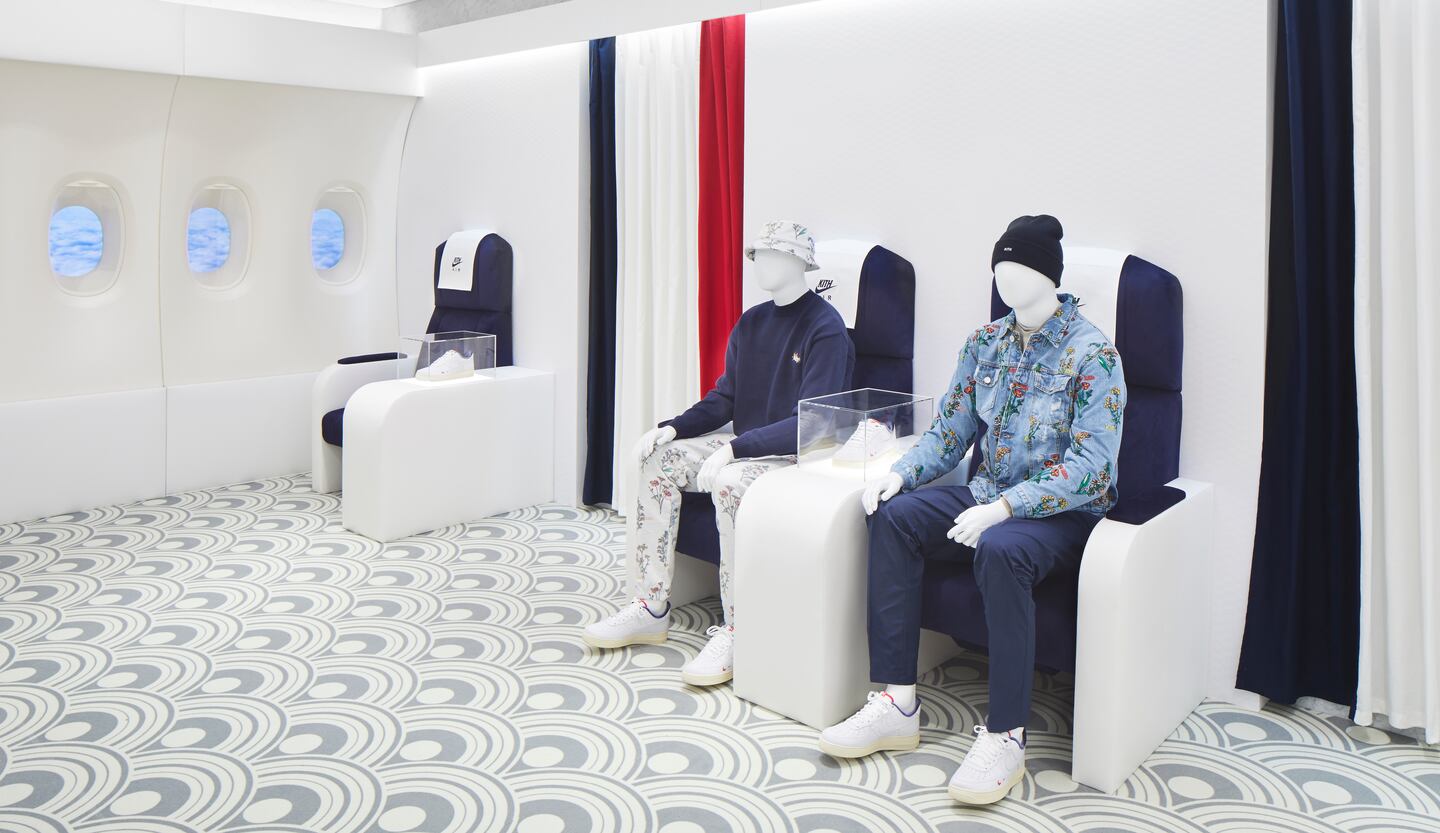
The Business of Fashion
Agenda-setting intelligence, analysis and advice for the global fashion community.

Agenda-setting intelligence, analysis and advice for the global fashion community.

If the pandemic brought the dream of the globe-trotting streetwear king down to earth, quite literally, Kith is still bought into the fantasy. A faux aeroplane cabin complete with reclining “Kith Air”-branded seats dominates the upper floor of the brand’s newest and largest store, which launched this month just off the Champs Élysées in Paris.
Kith’s first standalone outpost in Europe is pure retail theatre and a bold bet that neither the internet nor the pandemic has dealt a decisive blow to brick-and-mortar retail. It’s also a major milestone for Kith’s founder, chief executive and creative director Ronnie Fieg, 38, who grew up in Queens, New York, as the child of Israeli immigrants and has managed to turn a retailer that launched 10 years ago selling sneakers into a lifestyle brand. Just don’t call it “streetwear.” Like other pioneers of the category, Fieg considers the term an oversimplification.
In Paris, shoppers working their way through the building’s original glass-covered courtyard and up its iron-wrought marble staircase will encounter Kith’s signature merchandising mix: Kith-branded apparel, like elastic-waist cotton pants and embroidered floral denim jackets, alongside the latest sneakers, apparel and accessories from New Balance, The North Face, Fear of God, Stone Island and Gucci. Prices range from €8 for a Kith dessert to €20,000 for vintage Louis Vuitton boxing gloves.

“It’s almost like a Tommy Hilfiger for the next generation of consumers,” said David Fischer, founder and publisher of Highsnobiety. “Something that [is] at the scale of a Kith store in New York City in Soho or at the scale of Paris, I don’t think you can call that niche anymore.”
ADVERTISEMENT
The Tommy Hilfiger comparison makes sense in more ways than one. Both Hilfiger and Kith trade on a kind of nostalgia for the recent past, and have aligned their brands with hip-hop and sports culture. Both embraced the power of the logo from the start, allowing them to expand into new product categories at will. (The two companies also collaborated on products in 2018 and 2019.)
Kith hasn’t quite managed to match Hilfiger’s brand recognition or billions of dollars in annual sales (the company declined to disclose financial metrics). But Fieg has built a mini-empire of his own, with seven stores and three shop-in-shops across three continents, a team of 386 employees, more than 3.8 million followers on seven Instagram accounts (including Fieg’s personal), tight relationships with the biggest streetwear, activewear and fashion brands and a seemingly constant stream of logo-fied, limited-edition collaborations.
Fieg said he doesn’t have a roadmap for future store openings. Unlike Supreme, which became a streetwear juggernaut with private equity backing before selling to VF Corp, Kith only counts Sam Ben-Avraham, the founder of the now-shuttered multi-brand contemporary shop Atrium and trade shows including Liberty Fairs, as a co-founder and hasn’t taken on investors to accelerate growth.
“My interest is not to scale … I would have sold the company by now,” said Fieg. “We’re working really hard to make sure that the brand and the company is in the best position not only to grow but, most of all, to sustain. The growth that we had from last year to this year — now you need to sustain that before you can grow it and make sure that you’re healthy.”
The Kith Playbook
Kith started as a multi-brand boutique for sneakers, boots and leather shoes with two small shops in Soho and Brooklyn in 2011, and quickly established itself with a steady stream of limited-edition collaborations. Soon Kith unveiled its first in-house product, the Mercer jogger, which helped to establish the dominant men’s pants trend in the mid-2010s. But the turning point came in 2014 when Kith expanded its apparel line and started selling clothing from third-party brands.
As the streetwear trend went mainstream, Kith made it easy to pick up the requisite parts of the new uniform du jour for status-seeking young men: limited-edition sneakers paired with tailored sweatpants and oversized, branded sweatshirts. Its shoppers aspired to a New York City sense of style that developed out of the worlds of hip hop, Japanese fashion and sportswear. Logos were king.
“What it was for [kids] growing up wearing a Tommy Hilfiger sweatshirt or a Polo [Ralph Lauren] sweatshirt, that’s what Kith is today,” said Eugene Rabkin, writer and founder of Style Zeitgeist. “I believe it will be embedded in male fashion vocabulary for a very long time.”
ADVERTISEMENT
Collaborations were key to the formula.
“When you get a fresh pair of [Clarks] Wallabees, the beige suede, the smell, the wrapping, the box — it’s like this whole thing that I have a crazy affinity for,” said Fieg. “Then you add this element of a twist of design and exclusivity to where it’s not available to everyone worldwide, so you don’t have to run into the situation where the person next to you has it in school, or the person next to you has it at work,” he continued. “I wanted to offer that to people and put my own perspective on it so that I can help build an emotional connection.”
To date, Kith has collaborated with a wide breadth of major brands, from Coca Cola and Nobu to Versace and Moncler. While the price range still varies widely, many collaborations have moved upmarket. As have Kith’s own pieces and wholesale offerings, which now also include brands like Saint Laurent and Louis Vuitton alongside Byredo fragrances and collectable Japanese Bearbrick figures.
Crucially, Kith’s stores, especially in Soho, became hangout spots fostering a sense of community. “There was no typical business plan behind the dollar per square foot that we spend, versus the dollar per square foot that we want to make,” said Fieg. Shoppers were also fed with weekly product drops, part of Kith’s longstanding “Monday Program” release strategy.
The Next Chapter
Kith faces challenges as it expands, not least the debt the brand owes to Black culture, a widespread issue across the streetwear industry, where, despite its roots in hip-hop culture, few Black-owned brands have found success. After Kith was criticised by its audience on social media for lack of diversity on its team and in its marketing images last June, Fieg promised he would do more to fight for racial equality, describing it as his responsibility as a business founder “that is continuously inspired by Black culture.”

The following month, Fieg hired Sharifa Murdock, a Black industry veteran, mentor and co-founder of trade show Liberty Fairs with Ben-Avraham, who had been previously advising the brand. As Kith’s new head of people, she is leading its human resources team and diversity and inclusion initiatives. Murdock will also help establish a corporate foundation to support underprivileged youth this year. In February, Kith signed onto Aurora James’ 15 Percent Pledge, promising to work to the goal of selling 15 percent of wholesale products from Black-owned brands. The company said it already surpasses that goal in the men’s category and plans to reach it in women’s this summer.
“Did we have the opportunity before? I feel like now the team is big enough and the platform is also big enough to where we can make a real impact,” said Fieg.
ADVERTISEMENT
It’s an issue that is increasingly key to desirability with streetwear consumers, said Aria Hughes, the deputy style editor at Complex. “Prior to the George Floyd and Breonna Taylor murders, there was always this undercurrent in streetwear, and conversations were had privately about how much brands are inspired by Black culture and don’t outwardly acknowledge it,” she said. “It’s something that is now top of mind for consumers: Who am I buying from, who are they supporting, who are they hiring?”
Kith also faces challenges on the women’s side of the business. “We tried a lot of things with women’s,” Fieg said. “I don’t know it as well.” But now he thinks Kith has the right team to build a more substantial business there.
For most of Kith’s history, its “special sauce” has been Fieg himself. But as the company grows, Fieg is learning that may no longer be enough.
“The company is now a brand of its own,” he said. “The team is now what’s making it possible — it’s not about me.”
Related Articles:
The Hustle Behind Kith, Ronnie Fieg’s Self-Made Sneaker Empire
Antitrust enforcers said Tapestry’s acquisition of Capri would raise prices on handbags and accessories in the affordable luxury sector, harming consumers.
As a push to maximise sales of its popular Samba model starts to weigh on its desirability, the German sportswear giant is betting on other retro sneaker styles to tap surging demand for the 1980s ‘Terrace’ look. But fashion cycles come and go, cautions Andrea Felsted.
The rental platform saw its stock soar last week after predicting it would hit a key profitability metric this year. A new marketing push and more robust inventory are the key to unlocking elusive growth, CEO Jenn Hyman tells BoF.
Nordstrom, Tod’s and L’Occitane are all pushing for privatisation. Ultimately, their fate will not be determined by whether they are under the scrutiny of public investors.